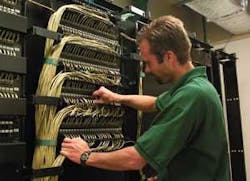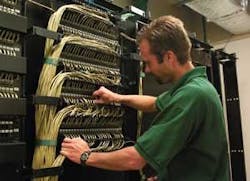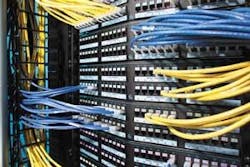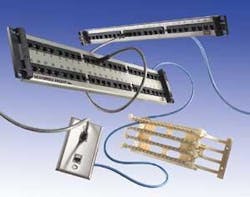As network speeds continue to increase, patch-cord management may mean more than just tidying up the TR.
Amidst today's equipment racks housing smaller electronics and higher densities, patch-cord slack is a major contributor to cable stress and loose connections at the cross-connect. With patch cords now recognized as the "weakest link" in the channel, patch-cord management is key not only for aesthetics and providing easy moves, adds, and changes, but also for ensuring maximum network performance.
Today's patch-cord management techniques and products are aimed at minimizing slack, controlling proper bend radius, and making it easier to administer and identify patch cords. And while many installers take pride in having a neat, well-organized patch cord system, as network speeds increase, patch-cord management is taking on additional significance.
Critical component
"Patch cords are so critical in the performance of the cabling plant today, that if you install a Category 5e patch cord into a Category 6 channel, the transmission performance of that entire channel will be reduced to Category 5e," says Mike O'Connor, director of technical marketing and services, Hubbell Premise Wiring (Stonington, CT; www.hubbell-premise.com). "Unfortunately, many generic patch cords are assembled with Category 6 cable and sub-par RJ-45 plugs, so they do not meet electrical requirements, such as NEXT and return loss."
Patch cords available from reputable industry manufacturers are tested for component specification and performance, but measuring transmission performance on such an electrically short assembly is difficult. Says O'Connor, "Proper training and test equipment is needed to adequately follow test requirements per TIA/EIA-568.B.2-1, which describes the Modular Plug Cord Test Procedure."
"It's important to test patch cords once they've been assembled, because tuning of the plug to the jack interface it's going into is critical," says Gregg LaFontaine, product manager for patch cords, Ortronics (New London, CT; www.ortronics.com). "The plug termination is where the relationship of the pairs is altered and the most noise is generated."
One function of patch-cord management is to ensure the quality of the critical patch-cord plug termination. "When a cord is plugged in at the top of the rack and allowed to drape down to the connection at the bottom with no management, the weight of the patch cord itself pulls on that top connector, putting stress on the termination," explains Dennis Mazaris, president of Concert Technologies, Inc. (www.concerttech.com) and inventor of the PerfectPatch (www.perfectpatch.com) solution.
Patch-cord management also helps maintain proper bend radius, although debate remains on what that bend radius should be. "When bending alters the arrangement of the pairs in the cable, the protection against crosstalk can be compromised," says LaFontaine. "There is no specified bend radius for patch cords, but most people try to maintain a bend radius similar to that of horizontal cable, which is specified at four times the cable diameter."
Big bend myth
According to Mazaris, the key isn't to maintain a large patch-cord bend radius as much as it is to stabilize the bend radius. "When you bend a patch cord, it has an effect on performance, and the more times you bend it, the greater the effect," says Mazaris. "People think they need a large bend radius, but stabilizing the radius so you can't keep moving the cable around is the best option."
TIA/EIA-568-B recommends cables never be kinked or tightly bundled, and the same holds true for patch cords. "In early installs, some took pride in a neat, tight dressing of the patch cords," says LaFontaine. "But since we've found tight cinching to degrade performance, we've moved away from cinching-type tie wraps to loosely applied Velcro, or no ties at all. When the cords are over-cinched, the construction of the cable and the relationship of the pairs to each other is altered, creating noise at that point."
Slack solutions
Patch-cord management solutions are available for controlling bend radius, taking up slack, and providing support for congested patch cords. Designed to help maintain a proper bend radius, vertical cable managers run alongside equipment racks to help rout patch cords between components on the rack. Horizontal managers provide a pathway on the front and rear of the rack to organize and guide patch cords into the vertical cable managers. "Without horizontal management, cables are less supported and more difficult to administer in the future," says La Fontaine. "Horizontal managers protect the patch cords and allow less disruption to other users during moves, adds, and changes."
Several new racking systems on the market integrate vertical cable management directly into the rack, feature hinged covers to conceal patch cords, and offer access to the entire vertical management. "Our integrated management system includes fingers to support every level of rack space," says LaFontaine. "Instead of cinching patch cords for a neat, clean appearance that might affect performance, the hinged doors provide the neatness by hiding the patch cords."
Most vendors have also made improvements to vertical and horizontal cable managers to accommodate today's higher densities and larger cable diameters. "We designed our horizontal cable management system around Category 6 cable with fingers that separate patch cords and offer more space for emerging applications, while maintaining compliant bend radius," says Hubbell's O'Connor. "With increasing cable diameters, management systems should be chosen to accommodate reduced fill rates and a bend radius of 1.25 inches or greater."
Since many end users do not have available rack space to use horizontal cable managers, an alternative solution is angled patch panel, which is "angled toward the vertical cable managers on both sides of the rack," says Paul Herbst, business development manager for copper systems, Panduit Corp. (Tinley Park, IL; www.panduit.com). "This allows the patch cords to feed directly into the vertical management, eliminating the need for horizontal cable managers and accommodating increased density."
In addition to vertical and horizontal managers, other patch-cord management products help eliminate messy patching fields. Some solutions provide storage that lets users store excess patch cable, while others help take up the slack. "In our studies, we found slack to be the biggest problem; no one knew what to do with it," says Mazaris, whose PerfectPatch lets installers gather cable slack to adjust its length and custom-fit the patch.
While many solutions help eliminate the "rat's nest" problem, education has been critical, too. "If you look at jobs 3 to 5 years ago versus today, there is a significant improvement in patch-cord management," says LaFontaine. "There's been a lot of education in the field, and today's field tests let you actually see if you have a good installation." According to LaFontaine, sometimes the best education is the corrective action. "If a customer has problems with their network, we might tell them to cut off a tight cinch tie and retest. That way they know what to avoid in the future."
Alien activity
The 10GBase-T (IEEE 802.3an) standard under development has identified alien crosstalk (ANEXT) as the significant parameter limiting 10-Gbit Ethernet performance over a 100-meter channel. Alien crosstalk is increased by the propensity of cables to absorb signals from neighboring cables in close proximity. "Studies show that ANEXT is a definite concern in the first 20 meters of a channel, such as where a 10-Gbit Ethernet switch powers several channels," says Panduit's Herbst. "Patch cords and cable that tend to merge together near the patch panel have the highest potential to be subject to ANEXT."
While alien crosstalk is a concern, current worst-case scenario testing of 10GBase-T applications maintains patch cords in close proximity to each other. "We polled some of our certified installers and found that aesthetics is a critical requirement of the end user," says Herbst. "We must ensure that they can continue to dress their patch cords using today's best management practices."
Future 10-Gbit Ethernet standards may include some recommendations related to troubleshooting the installed base of cable. "One recommendation to alleviate ANEXT might be to separate 10-Gbit Ethernet ports physically in the rack," says Herbst.
Mazaris points out that patching fields rarely remain neat and organized, and that cinching is typically temporary: "If ANEXT is a factor with patch cords, give it a couple of weeks and it won't be anymore. Closets don't stay neat and eventually nothing is running parallel, and it becomes a rat's nest. This could actually help alleviate alien crosstalk. But the disadvantages of a rat's nest—the weights of cables falling onto each other, the pulling of connectors, and the labor involved in moves, adds, and changes—are a nightmare and costs more money in the long run."
Future forecast
No one can yet say for sure whether changes in patch-cord management will be a primary solution for mitigating alien crosstalk; however, most industry professionals agree that good practices today will be supported in the future. "We don't believe installation practices will change much, and it will most likely be vendors incorporating specific techniques into their product designs to isolate and protect from ANEXT," says Hubbell's O'Connor.
Several vendors have already released 10GBase-T systems prior to the standard, and other solutions are waiting in the wings. By the end of this year, says O'Connor, "we'll be releasing our NEXTSPEED Ascent 6e+ system for 10GBase-T. This balanced system is designed to control ANEXT by electrically and physically separating ports and IDCs at the patch panel."
Panduit will also introduce their end-to-end solution for 10GBase-T by the end of the year, and when 10GBase-T electronics hit the marketplace, Panduit says it will offer a mitigation patch cord for the installed base.
"The mitigation cord is a unique solution that eliminates ANEXT close to the switch where the channel is the most susceptible and helps mitigate ANEXT in the remainder of the channel," says Herbst. "The mitigation cord significantly enhances the usable length of existing infrastructures to support 10-Gbit Ethernet."
LaFontaine says the industry will look at 10-Gbit Ethernet and alien crosstalk first from a performance standpoint and then from the perspective of installers and end users: "We typically will not ask the installer or end user to do something to accommodate ANEXT; instead, the problem will be solved through product design." LaFontaine believes, however, that when it comes to patch-cord management, there may be less organized bundling in the future, with patch cords flowing with some degree of randomness to help eliminate alien crosstalk.
"Sometimes, regularity is introduced by the installer, and this can be avoided by just letting patch cords fall where they're going to fall," says LaFontaine.
BETSY ZIOBRON is a freelance writer cover the cabling industry and a regular contributor to Cabling Installation & Maintenance. She can be reached at: [email protected]



